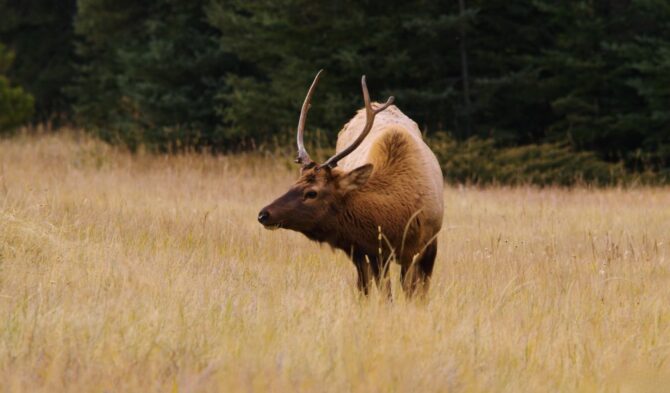Tennessee is officially known as the state of Tennessee and is located in the Southeastern region of the United States.
This is a wonderful state for people to visit due to the many natural attractions and vast wildlife.
Amongst the animals, there are owls that you’d often sight, making the state a good environment for owling.
There are eight different species of owls in Tennessee. Some live there permanently, while others take the state as a temporary home while migrating.
Some of these species include the barn owl, great horned owl, eastern screech owl, and barred owl, among others.
This article takes an in-depth look into these birds from the order Strigiformes. Read on to discover interesting facts about these species and how to recognize them based on their appearance, sounds, and migratory patterns.
The 8 Species of Owls in Tennessee
1. Barn Owl
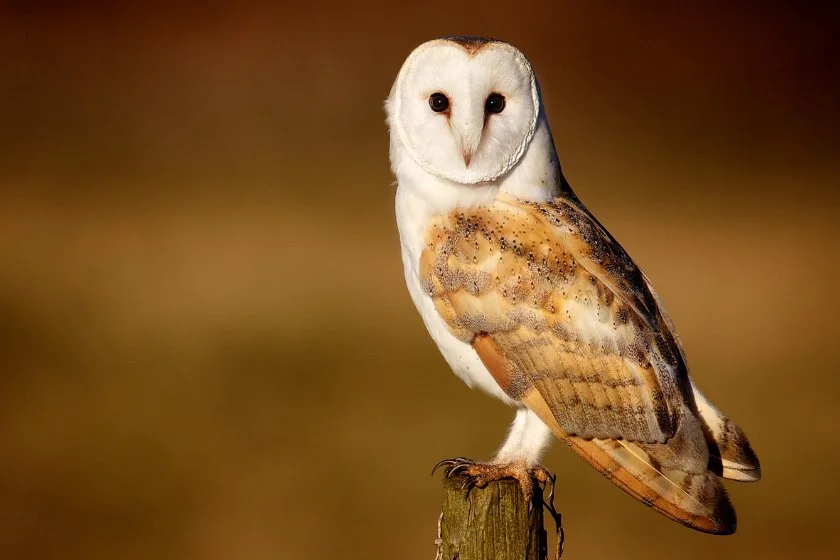
- Length: 13 to 16 inches
- Weight: 14 to 25 pounds
- Wingspan: 40 to 50 inches
- Scientific name: Tyto Alba
The barn owl holds the record of being the most widespread owl in the world and one of the most widespread birds.1
It is found almost everywhere and usually inhabits barns, though it can be found in many other habitats. This species is a native of Tennessee and can be easily seen.
While it resides in the state all year, it nests more during spring and summer. These are the best times to see one when owling.
Barn owls are medium-sized birds with long legs, long wings, and short tails. They have different subspecies, each with a particular size. The barn owl’s color is often described as pale, and its face is the shape of a heart.
The bird’s call is a shree, which is eerie and can be quite disturbing when heard up close. Contrary to what people might think, the barn owl doesn’t hoot. When you’re out seeking this species, listen out for a shriek.
Barn owls look scary and are often dubbed with monikers like ghost owls or demon owls.
However, it is not known to be dangerous, except to small mammals. Barn owls feed on them alongside birds, reptiles, insects, and fish.
It is mainly nocturnal, and the best time to see a barn owl is during dusk and dawn.
Simply look out for a white flying creature and listen for the shriek. Owls in Tennessee are willing to adapt to different habitats and may even be found around cemeteries.
2. Great Horned Owl

- Length: 18 to 25 inches
- Weight: 32 to 88 pounds
- Wingspan: 40 to 57 inches
- Scientific name: Bubo virginianus
The great horned owl is another impressionable bird that can be found in Tennessee. It is the most widespread true owl in the Americas.
It also goes by the names tiger owl and hoot owl. This bird often nests in Tennessee during the late fall and early winter.
The great horned owl is one bird people love to see, and given its physical appearance, this shouldn’t come off as a surprise. The bird has a heavy body, a large head, and very broad wings.
This ensures that you will see it, even though the color isn’t striking. Its upper parts are a mottled brown, and the lower parts are lightly colored with bars.
Overall, the great horned owl doesn’t seem like a bird that wants to be seen. It is a camouflage master for good reasons.
Rather than build their own nest, this species often camp in those of other birds. It is a nocturnal bird and hunts right after sunset, though it can step out under broad daylight to grab a meal. The best time to see this owl is at dusk.
Its diet consists of small mammals and generally any small animal it can get its claws on.
3. Barred Owl
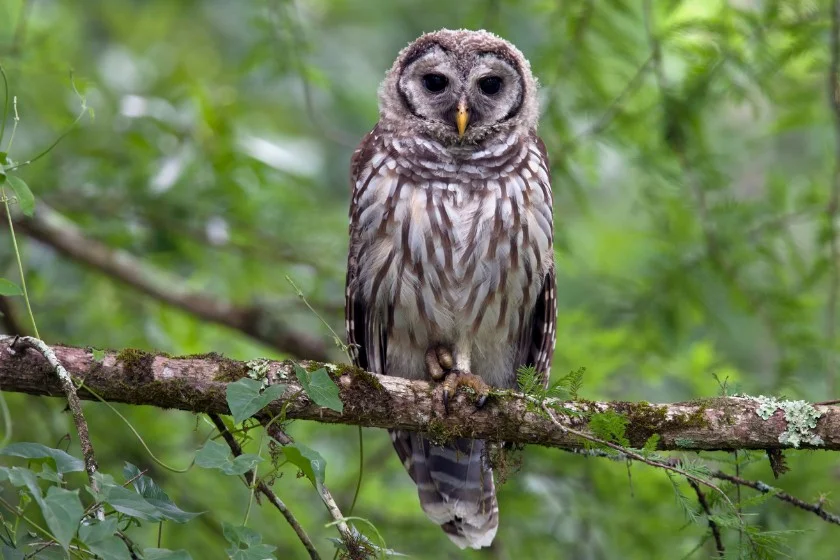
- Length: 17 to 20 inches
- Weight: 16 to 37 pounds
- Wingspan: 39 to 43 inches
- Scientific name: Strix varia
The barred owl is sometimes compared to the great horned owl, but it is smaller and has its traits, which include dark eyes.
It is commonly known for its stripes, which earned it both the names barred and striped owl. While a native to Eastern North America, it has since invaded the west coast.
This owl is easy to see in Tennessee because of its dark eyes. That said, it doesn’t have striking colors, similar to the great horned owl.
The upper part is a greyish brown or brown with white bars on the mantle and back. The lower parts are creamy.
One of the best ways to locate a barred owl is to listen for its call. It is known to be loud, going over 0.8 km. Its hoot sounds a lot like ok-ok-ok-ok-ok-buhooh.
To remember what the call sounds like, simply memorize the sentence “who cooks for you, who cooks for you all.”
The barred owl is an opportunistic predator, though it has small mammals as its diet. It also feeds on other birds, reptiles, amphibians, and invertebrates.
4. Long-eared Owl

- Length: 14 to 16 inches
- Weight: 8 to 15 pounds
- Wingspan: 36 to 40 inches
- Scientific name: Asio otus
The long-eared owl is first known for its catlike looks, earning it the second name, cat owl. It is also called the lesser-horned owl and the northern long-eared owl.
This bird has long feather tufts that seem like ears—hence its name—and is known to be large and scary looking. However, it doesn’t pose harm to humans.
This bird is not very common in Tennessee, but there are enough for them to be added to this list.
It often dwells in an abandoned nest and can be found in habitats with a lot of vegetation, like dense forests. If you want to attract a long-eared owl to your environment, have vegetation.
Its preferred diet is rodents like other owls. It can also feed on birds and insects, but rodents make up most of it. Long-eared owls mate during winter and spring.
You can spot them in those seasons. Their call varies but can include a deep whoop or something more like a yip.
5. Short-eared Owl
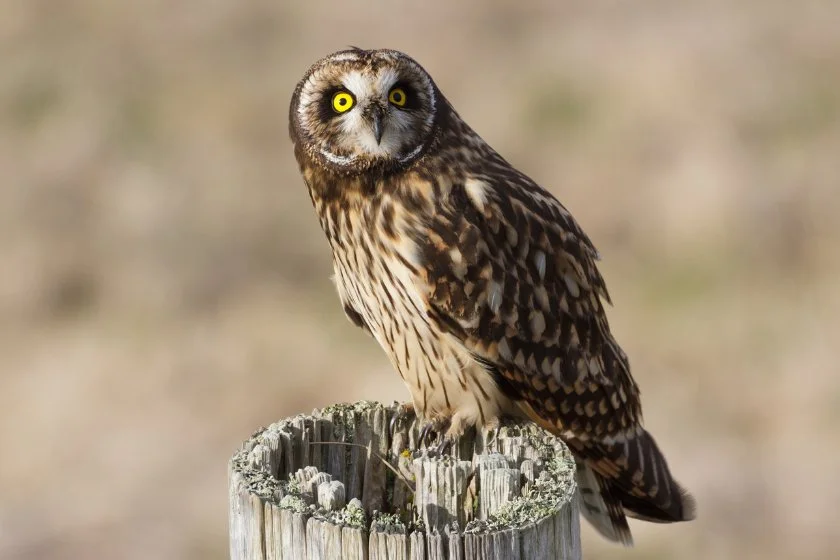
- Length: 14 to 17 inches
- Weight: 7 to 17 pounds
- Wingspan: 34 to 41 inches
- Scientific name: Asio flammeus
The short-eared owl is a seasonal bird in Tennessee due to its migratory nature, but you still have enough opportunities to spot one in this state.
It is known for its remarkable appearance, and it comes with short tufts that led to the name. It is related to the long-eared owl, though there are many differences between them.
Besides the almost invisible ear tufts, the short-eared owl has other features like a round head and short, barred tail feathers.
It also has large eyes, a short neck, broad wings, and a black bill. Its color is a mottled tawny to brown.
The short-eared owl doesn’t fly as smoothly as other species. It moves more like a bat because of its irregular wing beat. This is a dead giveaway.
Another way to locate the short-eared owl is through its call, often described as a scratchy bark. It can either sound like waowk-waowk-waowk or hoot-hoot-hoot-hoot.
This owl lives in nests located on the ground and would often come out at night to hunt. It goes mainly after rodents but isn’t limited to that.
6. Eastern Screech Owl

- Length: 6 to 10 inches
- Weight: 4 to 9 pounds
- Wingspan: 19 to 24 inches
- Scientific name: Megascops asio
The eastern screech owl comes with feathers that are colored grey, brown, or white. It is quite common in the eastern parts of North America, and it doesn’t migrate, which means you can find them in Tennessee for a long time.
It might be challenging to spot these birds because of their size and camouflage.
Its plumage is colored rusty or dark grey, which helps with the camouflage. It is also midsized, and while that’s bigger than many other species, it still helps the bird stay out of sight.
Other physical traits the eastern screech has are prominent ear tufts, a large head, yellow eyes, and a yellow beak.
If it proves difficult to locate an eastern screech, listen for its sound. The latter is more of a tremolo than a screech, as this bird does not truly screech. It can also purr.
These sounds are often noticeable once you know how to recognize them.
The owl is nocturnal, another feature that may contribute to it being hard to find. During the day, it sleeps in a hole, and at night it flies out to hunt. It feeds on lizards, rodents, and many other small animals.
7. Snowy owl
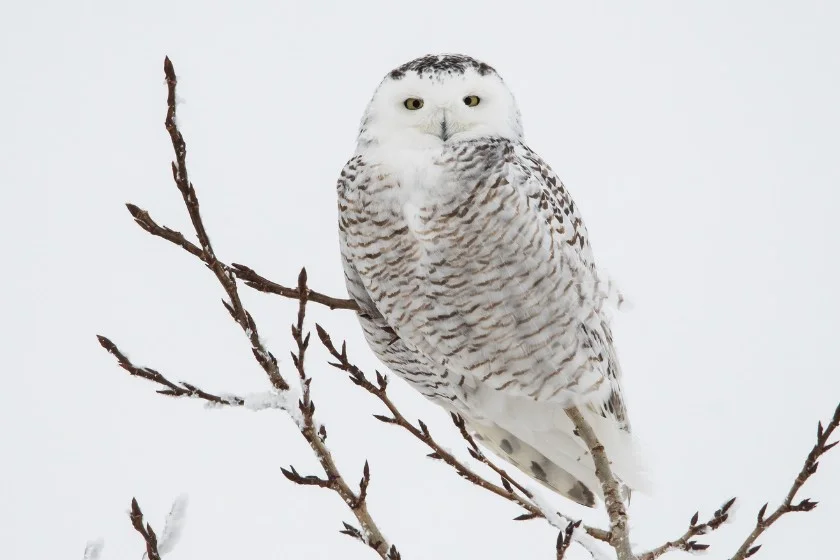
- Length: 21 to 28 inches
- Weight: 56 to 104 pounds
- Wingspan: 50 to 57 inches
- Scientific name: Bubo scandiacus
The snowy owl is a nomadic bird that is often found in the Artic tundra. It migrates to different parts and is hardly found in one area for a long time.
This bird is a sight because of its large size and white feathers. You won’t miss it if you see it.
However, it is rare in Tennessee. It is only included on our list due to occasional sightings. If you do see it, consider it good fortune.
This owl differs from other species because of its striking white plumage. It is even whiter than the polar bear.
Males tend to be whiter than females, which may have some spots. A good example of a snowy owl is Hedwig in Harry Potter.
This bird is a hunter and can be opportunistic. While its main meal is usually lemmings, it can also feed on other small mammals and birds. It is often active during the day, unlike some other owls.
8. Northern Saw-Whet Owl
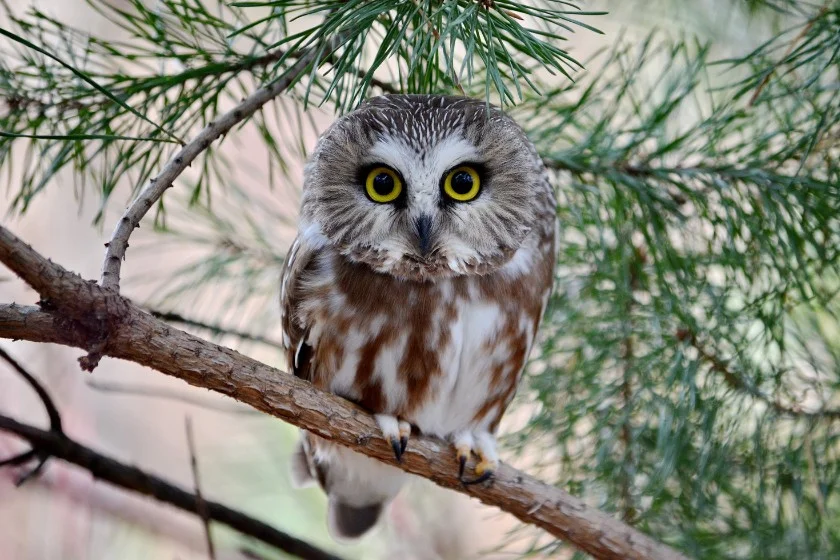
- Length: 7 to 9 inches
- Weight: 2 to 5 pounds
- Wingspan: 17 to 22 inches
- Scientific name: Aegolius acadius
The northern saw-whet owl is one of the small owl species that can be found in North America. It has a distinct sound, often compared to a saw being sharpened on a whetstone.
This is where it got its name. Preferred habitats of the saw-whet owl include coniferous forests.
This species is almost like the robin in size. It has a round face that’s colored white and streaked with brown and cream. It also comes with a dark beak and yellow eyes.
The Northern saw-whet owl is considered threatened in Tennessee, and the best place to find it is the eastern parts close to the Great Smoky Mountains National Park.
It often nests in tree cavities during the day and only comes out at night. Added to the fact that it visits the state during winter, you know it is a challenge to find one.
You’d have to be intentional, set out at night, and be very observant.
Northern saw-whet owls often come under attack from bigger birds but are also predators themselves. They feed on small animals like rodents, birds, and insects.
Conclusion
Tennessee is a good place to explore a variety of wildlife, including owls. There are eight species of owls in Tennessee, and all are a wonder to see.
Owling is more challenging for some species than others, but with enough diligence, you can locate anyone that catches your fancy.
Next up…
References & Notes
- Barn Owl. Wikipedia.

